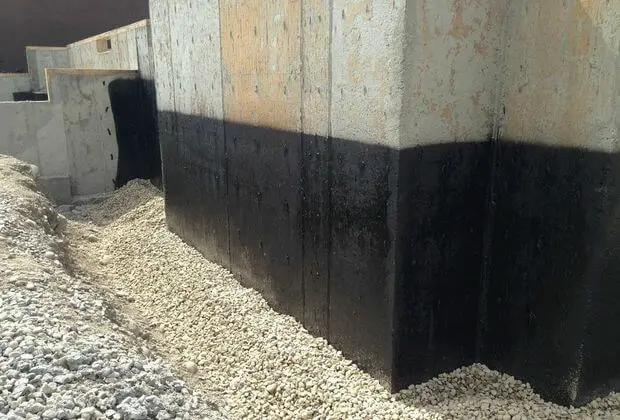
What is DPC (Damp Proof Course)?
The damp proof course is a process that is applied at the basement of the structure in order to restrict the flow or any movement of dampness through walls and floors. DPC full form which stands for Damp proof course as mentioned above.
Below we will be discussing various damp proof courses (DPC) uses causes, and effects in detail.
Dampness Causes in Buildings
Following are the reasons that cause the dampness in the building.
- Poor design of the building.
- Poor workmanship can cause faulty construction.
- Poor materials can be a major cause of dampness.
- Poor drainage, imperfection orientation, and imperfect roof slope, etc.
- Improper or absence of waterproofing to the structure may result in the entry of rainwater.
Effects of Dampness in Building
- Dampness may cause softening and crumbling of plaster.
- Due to the entry of moisture the steel used in the structure may get corroded.
- Dampness promotes the growth of termites which can badly affect timber items.
- Chances of short-circuit are high due to the entry of moisture in electrical lines.
- The wooden furniture may get deteriorated when it comes in contact with dampness.
- Dampness may cause bleaching and flaking of paints.
- Dampness may result in unhealthy and difficult living and working conditions for the residents.
Methods of Damp Proofing
There are several methods of damp proofing which are commonly adopted during DPC in construction.
- Guniting
- Pressure Grouting
- Cavity wall Construction
- Surface Treatment
- Integral Damp Proofing
- Membrane Damp Proofing
Guniting
Guniting is a process of depositing an impervious cement mortar of 1:3 cement sand mixture which is shot on a clean surface from a distance of 75 to 90 cm by using a cement gun with a pressure of 2 to 3 kg/cm2. The deposited mixture must be cured at least for two weeks.
Pressure Grouting
Pressure grouting is the process of filling cement grout into cracks, voids, fissures, etc under a pressure. This helps in consolidating and enhancing building water penetration resistance.
Cavity Wall Construction
Cavity wall construction is a process of forming a cavity between the main wall and cavity wall which helps in preventing the entry of water or moisture into the main wall, thus making the structure damp proof.
This Damp proof course (DPC ) technique is more effective.
Surface Treatment
Surface treatment is a process where the particular area or surface is applied with a layer of water repellent compounds or substances that prevents the entry of moisture.
The most common way to protect the surfaces is by Plastering and painting with waterproof agents like potassium silicates, aluminum or zinc sulfates and magnesium sulfates, etc.
The surface treatment gives better results only when the mixture is superficial and not under pressure. Sometimes exposed stone walls and brick walls are generally sprayed with water-repellent solutions.
Integral Damp Proofing
Integral damp proofing is a process where waterproofing compounds are mixed into the metal or concrete of the building in order to make the surface impermeable.
Membrane Damp Proofing
Membrane damp proofing is one among the methods of Damp Proofing, In which a water repellent membrane is inserted in between the source of dampness and the structure part adjacent to it.
Materials like bitumen, polythene sheets, bituminous felt, and metal sheets, etc are used for damp proofing.
Material Properties used for Damp Proofing Course (DPC)
The material used in DPC must possess the following characteristics.
- The material must be affordable.
- The material must possess the same durability as the structure.
- The material must be strong enough to withstand superimposed loads.
- The material used in DPC must have leak-proof joints.
- The material must be placed in rigid conditions.
Types of Materials used for Damp Proof Course (DPC)
There are mainly three types of materials used to check Dampness
- Flexible Materials – In this type, materials like bitumen felts, plastic sheeting are considered.
- Semi-rigid Materials – In this type, materials like mastic, asphalt, or a combination of materials are considered.
- Rigid Materials – In this type, materials like first-class bricks, stones, cement concrete, and slate, etc. are considered.
Material Used for Damp Proof Course
- Asphalt
- Bitumen
- Bitumious or Asphaltic felts
- Metal sheets
- Stones
- Bricks
- Plastic Sheets
- Mortar
- Combination of sheets and felts.
Also Read – Top 10 Unique Buildings in the World
FAQ’s on DPC(Damp Proof Course)
1. What is DPC full form in civil engineering?
Ans – DPC full form in civil engineering stands for Damp Proof Course.
2. What materials are used in the Damp proof course?
Ans – Materials such as Asphalt, Bitumen, Bituminous or Asphaltic felts, Metal sheets, Stones, Bricks, Plastic Sheets, Mortar, and Combination of sheets and felts.
